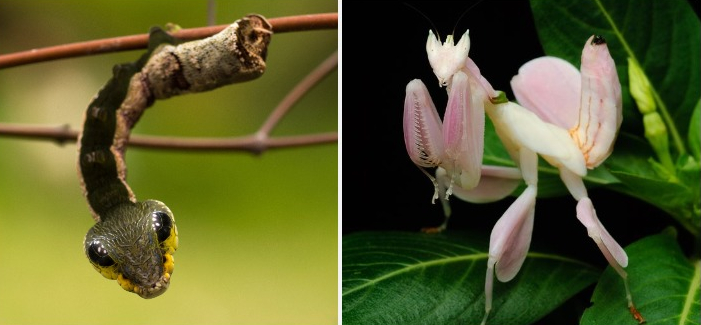Camouflage and mimicry are a defense mechanism that help insects to blend in with their surroundings. Some insects often use cryptic coloration, and others have evolved an impressive array of biological mimicry and deception. They do it to conceal their presence and escape predators, or to deceive their prey. Researchers have long been fascinated with mimicry, and it was camouflage and mimicry that helped convince them of the power of natural selection. Insects that can merge with their backgrounds are less likely to be eaten and are able to pass on their genes (and their natural disguises) to future generations. It was discovered that a certain type of leaf mimicry dates back much further than experts believed, to the time of the dinosaurs.
Here are some of the most amazing masters of disguise and deception in nature.
1. Dead leaf mantis
Dead leaf mantis englobes various species of praying mantis that mimic dead leaves. Their common name is due to their resemblance to dead, leafy vegetation, including having a large flattened thorax and “elaborate leaf patterns” on their wings. Phyllocrania paradoxa, commonly known as Ghost mantis, is a small species of dead leaf mantis from Africa. Its distinct and unique camouflaged appearance of a dry weathered leaf is remarkable. Compared to many other praying mantises, the ghost mantis is considered a “miniature species” measuring only about 45 to 50 mm (1.8 to 2.0 in) long. This mantis occurs in various shades of brown, from dark to light brown to greenish gray. Its color is determined by the environment – a more humid environment will yield a greener individual.
The Ghost mantis has an elongated ‘cone’ emerging from its head, an extended prothorax and leaf-like protrusions from its limbs. As well, it has a forewing that looks like a desiccated leaf, and the “creases” in the wings are actually shadings of pigment. These features help the mantis to effectively blend in among dead fallen leaves, making it hard to be spotted by predators. By remaining still, the Ghost mantis also goes unnoticed while waiting for its own prey. If threatened by a large prey, big nymphs and adult females feign death by lying motionless on the floor, while males tend to run away frantically.
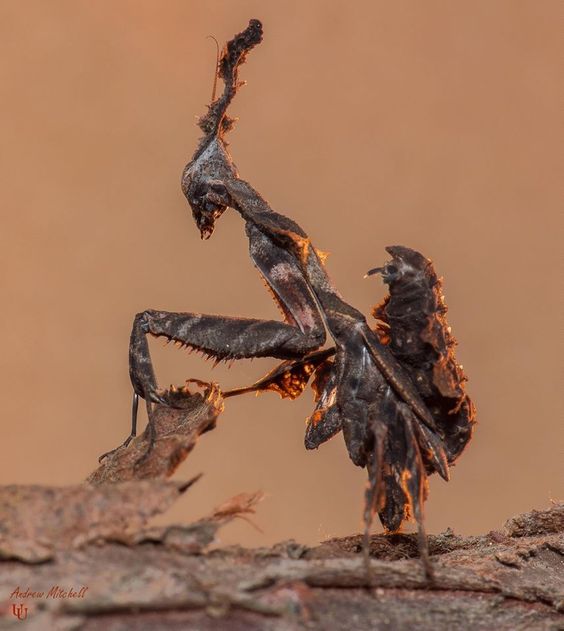
Credit: Andrew Mitchell

Credit: Cathy Keifer
2. Dead Leaf butterfly (Kallima inachus)
Kallima inachus, known by its common names the Orange oakleaf, Indian oakleaf or Dead leaf, is a nymphalid butterfly found in India, Nepal, Bhutan, Bangladesh, and Myanmar, down to Tenasserim Hills, and also in Southeast Asia. When in the closed position, the butterfly wings appear like a dry leaf with dark veins. These underside wings consist of irregular patterns and striations in many shades of biscuit, buff, browns, yellow, and black. The darkened veins make the resemblance to a dried leaf extremely realistic. When the wings are open (the upper side), the forewing displays a black apex, an orange discal band and a deep blue base. There are two white oculi, one along the edge of the apical black band and the other bordering the orange and deep blue areas. The hindwing is mostly a uniform blue, but speckled with brown patches along the termen.
When pursued by birds, the orange oakleaf flies erratically, quickly drops down among leaves and adopts a stationary pose with wings closed to merge with its surroundings. In this position, the butterfly is perfectly camouflaged and manages to fool the predatory birds, who very often are unable to spot it.
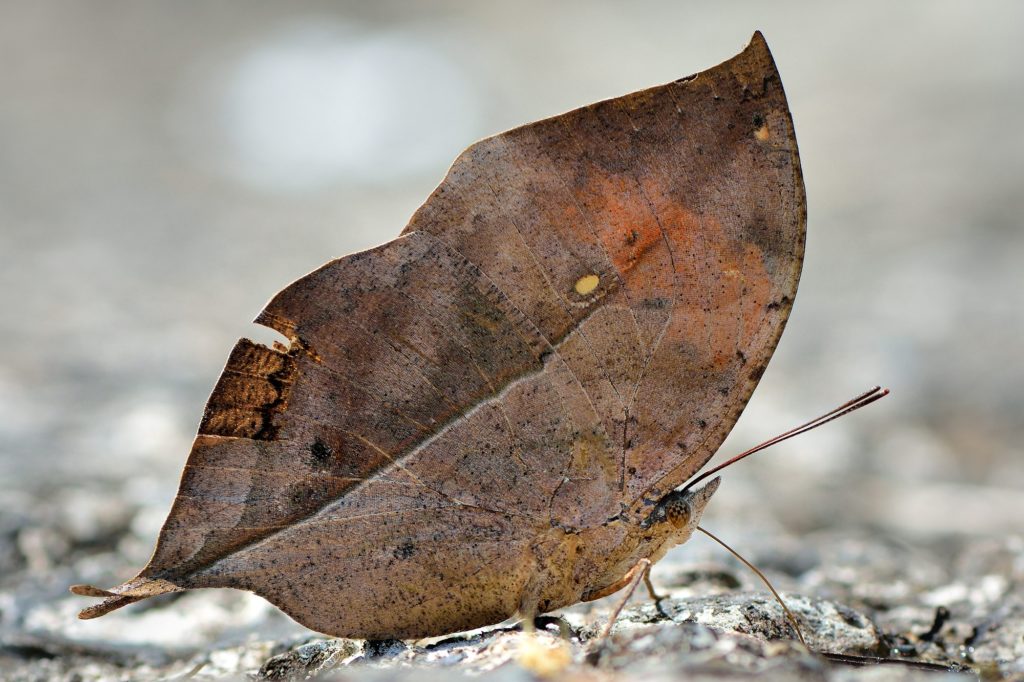
Credit: JamesHou/Shutterstock
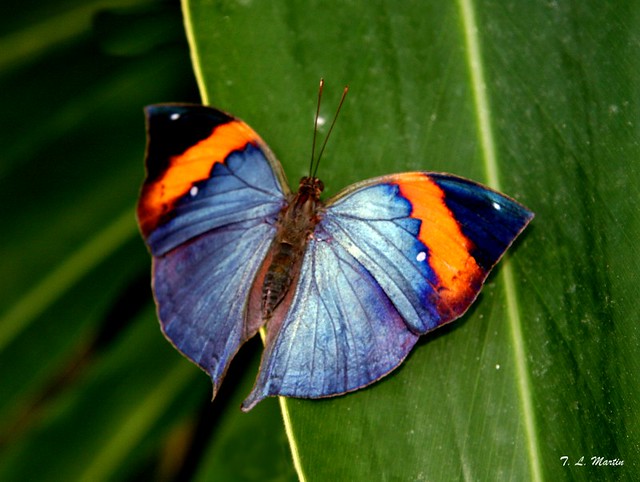
Credit: Tim Martin
3. Leaf-mimic Katydid
Leaf-mimic katydids are part of a group of insects known as Pterochrozini, which mimic leaves. Katydids are mainly found in humid tropical areas, but some reside in North America. They truly are masters of cryptic coloration and mimicry, taking camouflage to another level. Indeed, they not only imitate new green leaves but speckled, decaying, and chewed leaves. Some “leaves” even have “holes”, which are in fact areas with a translucent membrane window. Katydids can remain still for several hours and it is believed that these critters adopt some specific positions that allow them to blend in with adjacent vegetation and thus enhance their camouflage. What’s more fascinating, within a single species, no two individuals are exactly alike.
The principle predators of the leaf-mimic katydids are monkeys. Primates are smart, and they search for tasty katydids in a methodical fashion. That is why each katydid has evolved its own unique way to imitate a leaf. If fake leaves are as irregular, differently colored and patterned in appearance as real leaves, this renders the monkey’s task more difficult. However, if their disguise fails, katydids quickly employ their secondary defenses: they normally display brightly colored hindwings (often decorated with eyespots) to startle predators and some can secrete poisonous or distasteful chemicals to deter them.
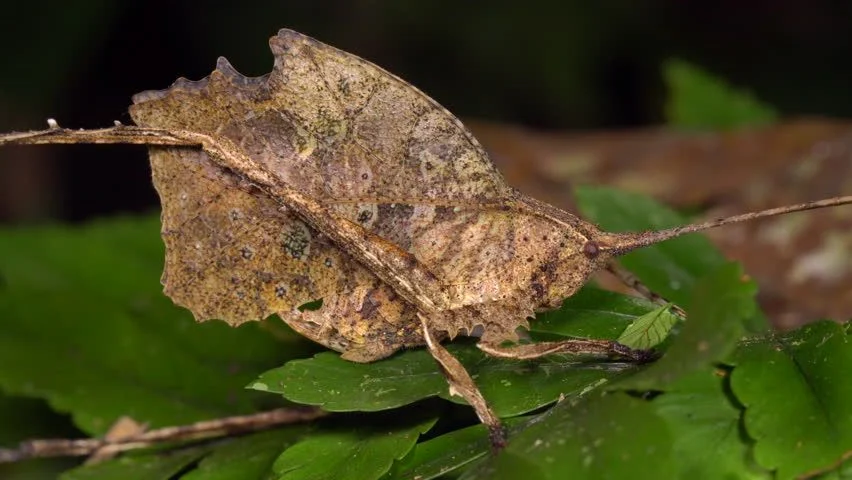
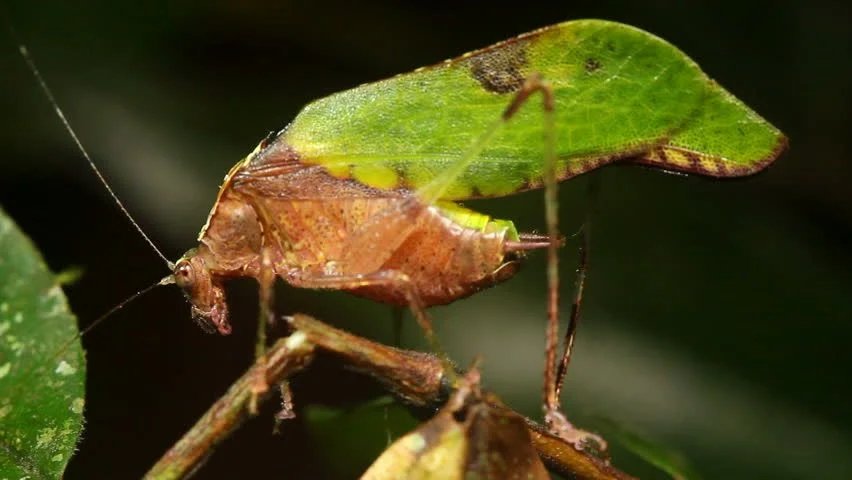
Credit: Dr Morley Read / Shutterstock
4. Walking stick insect
Also known under various names like stick insects, stick-bugs, stick animals, or bug sticks, these insects form part of the Phasmatodea order (also called Phasmida, Phasmatoptera or Spectra). They are found on all continents except Antarctica, but they are most abundant in the tropics and subtropics. These insects can be relatively large, and depending on the species, their sizes range from 1.5 cm (0.6 in) to over 63 cm (25 in) in length, with females usually growing bigger than males. This makes them the biggest insects in the world.
Stick insects are a group of highly camouflaged insects and are able to escape their predators by merging with their surroundings. Some phasmids have cylindrical stick-like shapes, and may even imitate the movement of a twig in the wind by swaying back and forth. Other species have flattened, leaflike shapes, and some are covered in mossy or lichenous outgrowths that supplement their disguise. Alternatively, when camouflage is not enough, some species employ methods to startle the predator by flashing brightly colored patches hidden under their wings and making a loud noise. Others have developed the ability to release foul-smelling chemicals to discourage predators, or even secrete a liquid that temporarily blinds their foes.


Credit: Fritz Geller-Grimm and Felix Grimm
5. Flower mantis
Flower mantises are praying mantis species that bear specific colorations and display behaviors that mimic flowers in their surrounding habitats. The majority of the known species belong to the family Hymenopodidae. Their special form of camouflage referred to as Aggressive mimicry is used not only to escape predation, but to lure prey as well.
The Orchid mantis (Hymenopus coronatus) is one of several species of Flower mantis, and it mimics parts of the orchid flower. Its body is often white with pink markings, and it has green eyes and lobes on its four walking legs that resemble flower petals. This allows for this species to stay hidden from predators such as birds, but simultaneously catch pollinating insects that are attracted to the flowers. The Orchid mantis employs a technique where it absorbs UV light the same way that flowers are able to, thus making the mantis appear like a flower to UV sensitive insects. It ambushes foraging butterflies by capturing them with its pair of toothed arms and powerful bite.
These insects display different body morphologies depending on their life stage; juveniles are capable of bending their abdomens upwards and mimic a flower, while adults’ wings are too large, inhibiting this ability. An adult female is approximately 6 to 7 cm long, while the male is much smaller, being only about 2.5 cm, and with almost no lobes on the legs.
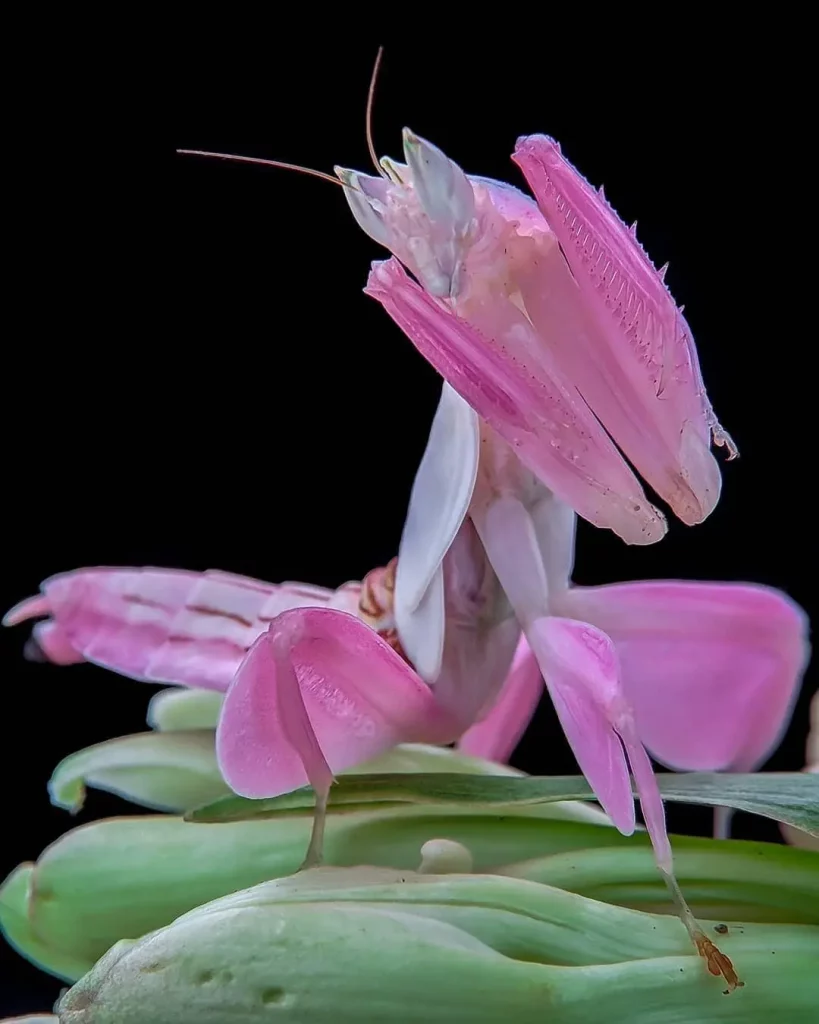
Credit: Muhamad Ikhsan
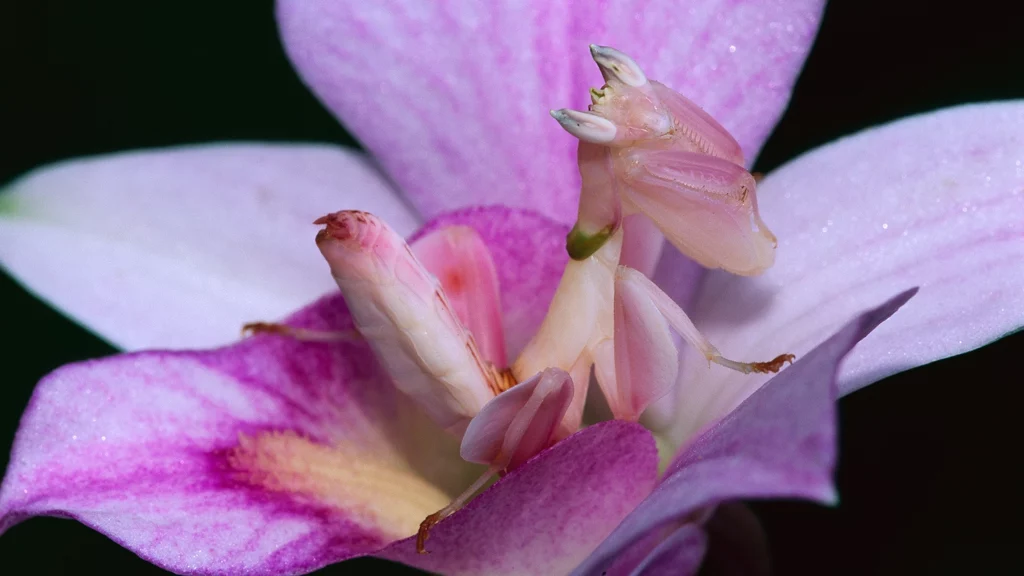
Credit: Thomas Marent / Getty Images
6. Walking leaf insect
Walking leaf insects, of family Phylliidae, consist of more than 50 species of flat, usually green insects (order Phasmida, or Phasmatodea) that are known for their striking leaflike appearance. Their range extends from South Asia through Southeast Asia to Papua New Guinea and Australia. These insects measure between 28 and 100 mm (1.1 to 3.9 in) long, with males being smaller than females. In one of the largest known species, Phyllium giganteum, females may exceed 100 mm.
Leaf insects are known for their elaborate mimicry of leaves, with the insects’ wings and legs closely imitating leaf color and form. The vein pattern of female elytra typically looks like the midrib and veins in a leaf. To make the resemblance even more realistic, some species are adorned with markings similar to spots of disease, decay or damage, including “holes” (areas with a translucent membrane window). The edge of the leaf insect’s body even has the appearance of bite marks. Some other species possess rows of tubercles on their antennae that, when rubbed together, produce sounds that may scare off predators. Leaf mimicry is done so accurately that it makes it hard for predators to be able to distinguish the insects from real leaves. To further confuse predators, they may also rock back and forth, mimicking the movement of a leaf in the wind.
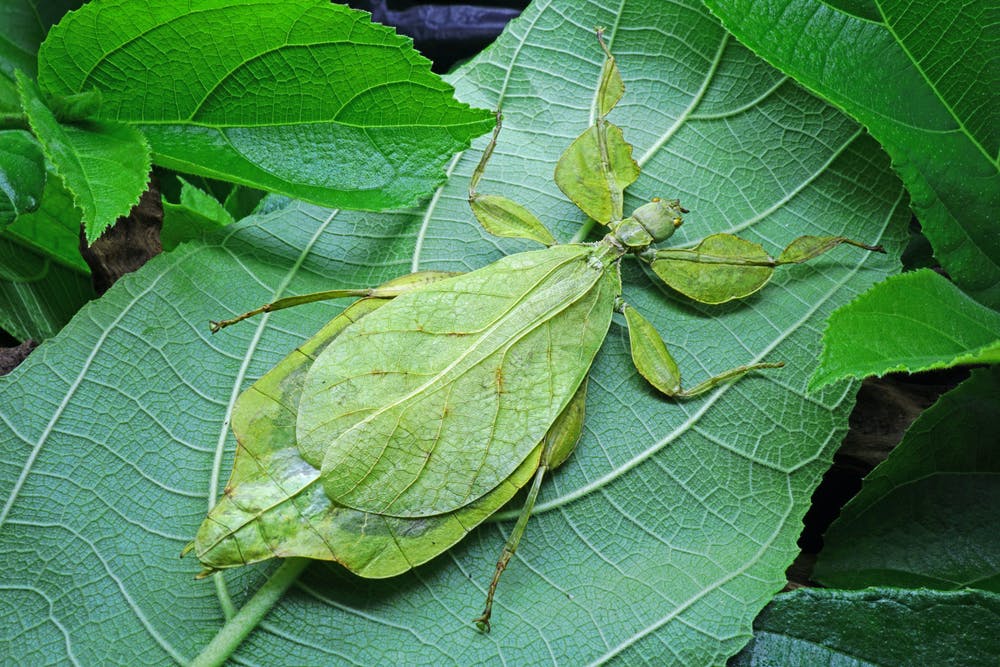
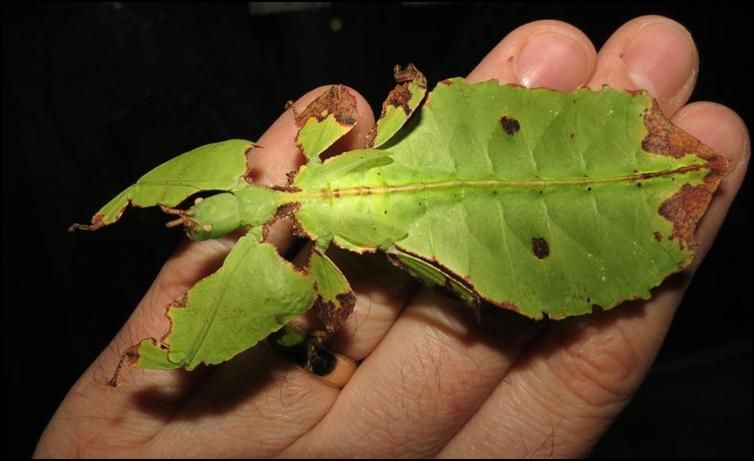
7. Common baron caterpillar (Euthalia aconthea)
The Common baron caterpillar (Euthalia aconthea) is native to India and South East Asia. In its larva form, the Common baron has evolved to be very well camouflaged on green leaves to avoid being detected by predators. This camouflage increases its survival rate, so it is more likely to reach the metamorphosis stage in which it will develop into a butterfly and reproduce.
The species, common in Singapore, is usually found on mango tree leaves and is sometimes considered a pest. The larva hatches from the underside of a leaf and as it grows in size, branch-like extensions emerge from its sides to help it crawl on leaves. With a yellowish-white spine and a bristled appearance, the caterpillar blends into the background and becomes one with the mango leaf. Its spine lines up with the midrib of the leaf and its feather-like bristles become almost invisible against the green, making it quite difficult to detect them. When it’s not resting on a green leaf, the Common baron caterpillar looks like a bunch of pine needles clumped together.
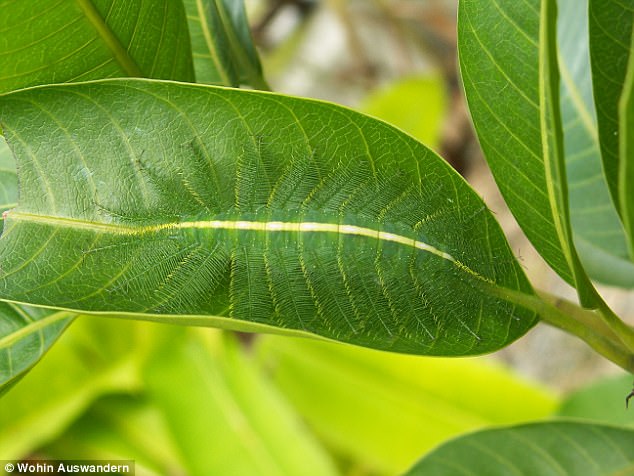
Credit: Wohin Auswandern
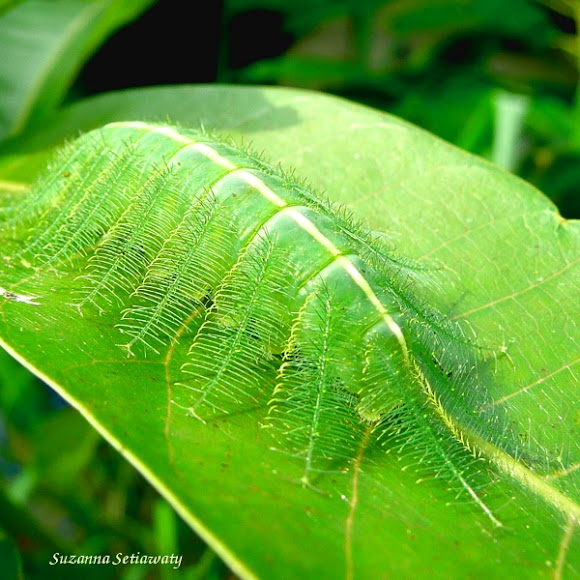
8. Dead leaf moth (Uropyia meticulodina)
Uropyia meticulodina, commonly called the Dead leaf moth, may be one of the best dead leaf mimics in nature. It is a species of moth of the family Notodontidae, found in Taiwan, Japan and the Chinese provinces of Yunnan, Hubei and Shaanxi. What’s incredibly fascinating is that it is not just brown like a dead leaf, but it’s brown like a curled up, dead leaf. Its resemblance to a dead leaf curled up on itself, accentuated with tiny leaf-like veins is just uncanny. Its wingspan is between 45–55 mm.
However, this mind-blowing mimicry is mostly an optical illusion. The wings may appear curled up, but they are actually as straight as those of any moth. The curled up effect is due to the minute scales on its wings, which even replicate the shading of a curled up dead leaf. This is similar to a leaf which catches the light, with shadows in all the right places. In the moth, you can even notice the veins casting tiny shadows along the curled underside.
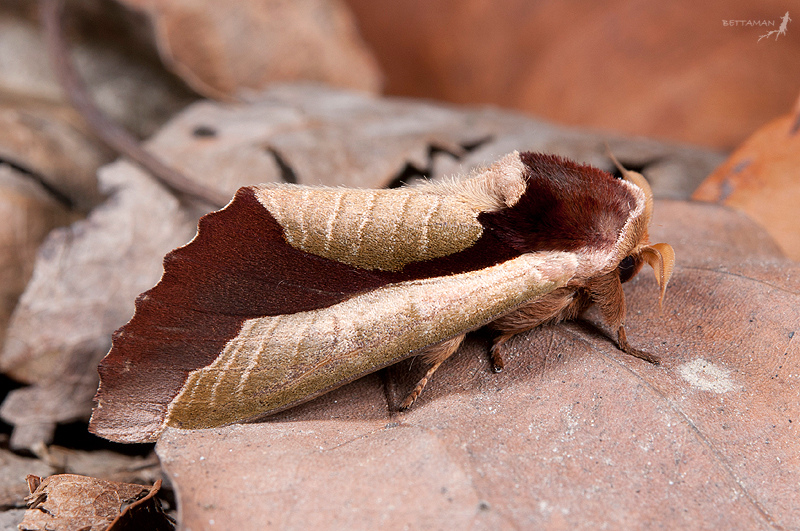

9. Pink underwing moth caterpillar (Phyllodes imperialis)
Phyllodes imperialis, commonly known as the Imperial fruit-sucking moth or Pink underwing moth, is a noctuoid moth species in the family Erebidae found in parts of Queensland and New South Wales, Papua New Guinea, Solomons, Vanuatu and New Caledonia. Mature caterpillars are mainly dark to reddish brown and have diagonal shading and thin wiggly white lines. Their abdomens are marked with black, yellow, and red streaks on each side. The caterpillar apparently relies at least in part on crypsis to avoid detection by predators, as it sits flat against the vine, appearing like a dead leaf or branch.
If it feels threatened, the caterpillar rears its front body segment and curls its real head as well as its true legs beneath the raised portion of its body. In doing so, it stretches the skin on its dorsum and reveals the previously-concealed ‘eyespots’. These ‘eyespots’ actually consist of a pair of black pupils, surrounded by a blue, then yellow ring. Below the ‘eyespots’ are a double row of white teeth-like markings, which somehow resembles the teeth from a cartoon skeleton. This remarkable illusion would be sufficient to scare off any potential predators!
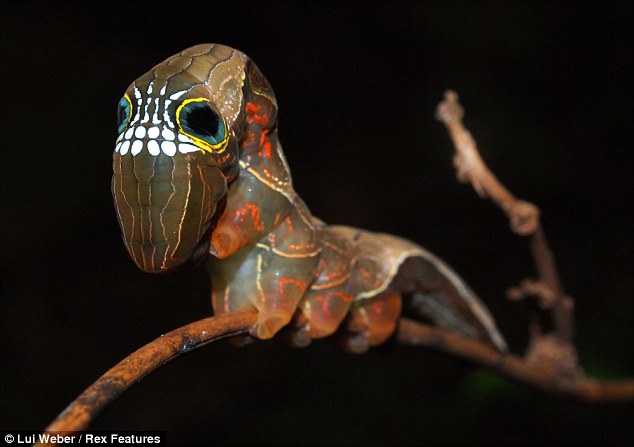
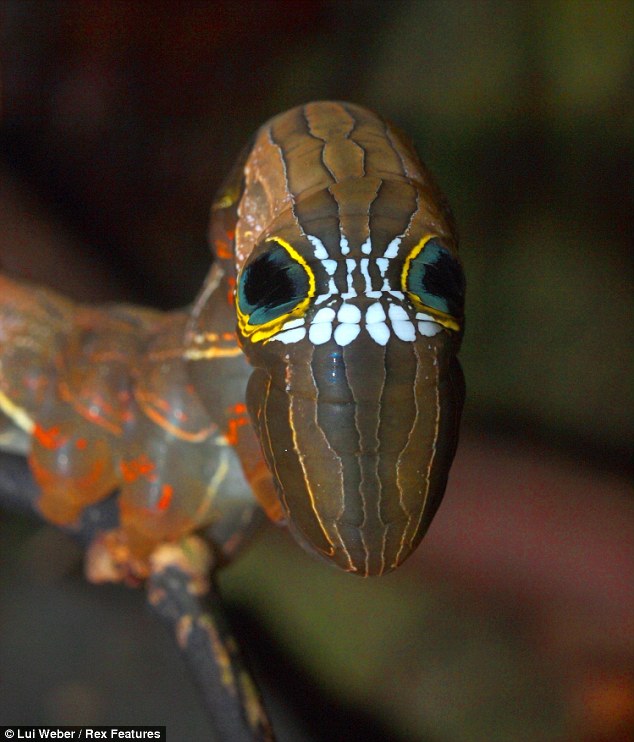
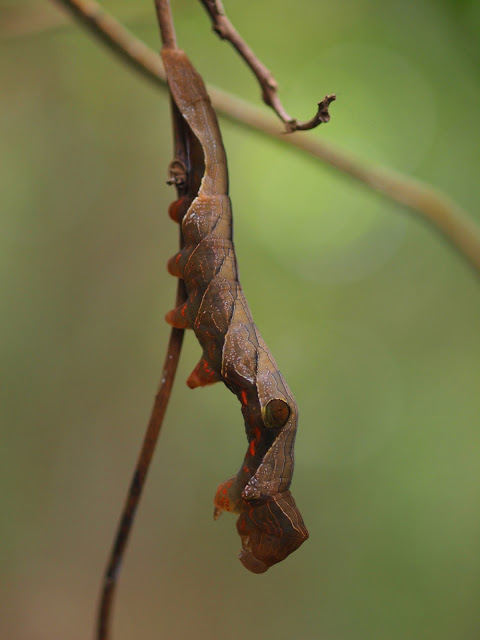
10. Sphinx (or Hawk) moth caterpillar
Sphinx moths, also colloquially known as Hawk moths, form part of the Sphingidae family of moths (Lepidoptera order), which comprises about 1,450 species. Sphingid caterpillars are medium to large in size, with stout bodies. Many are cryptic greens and browns, with countershading patterns to help with camouflage. Others have more prominent colors, typically with white spots on a black or yellow background. Some tropical species are thought to mimic snakes.
One of the species, Hemeroplanes triptolemus, in its caterpillar form, is capable of enlarging its anterior body segments to give it the appearance of a snake, including the ‘eyespots’. The caterpillar goes even as far as imitating a snake’s behavior – it actually throws itself backwards and twists to reveal its usually hidden underside, patterned in faux snakeskin. By sucking in air through tiny holes in its surface, the caterpillar inflates the front part of its body (head-end) to form a triangular-shaped head. When fully expanded, this creates the illusion of a snake-like head with venom glands and eyespots that appear to glisten. If somehow the snake-shaped head is not sufficient to deter predators, the caterpillar takes the snake mimicry to yet another level. It will actually lunge at its potential predators as if to strike, but with a non-existent venom – a defense strategy which seems to be effective.


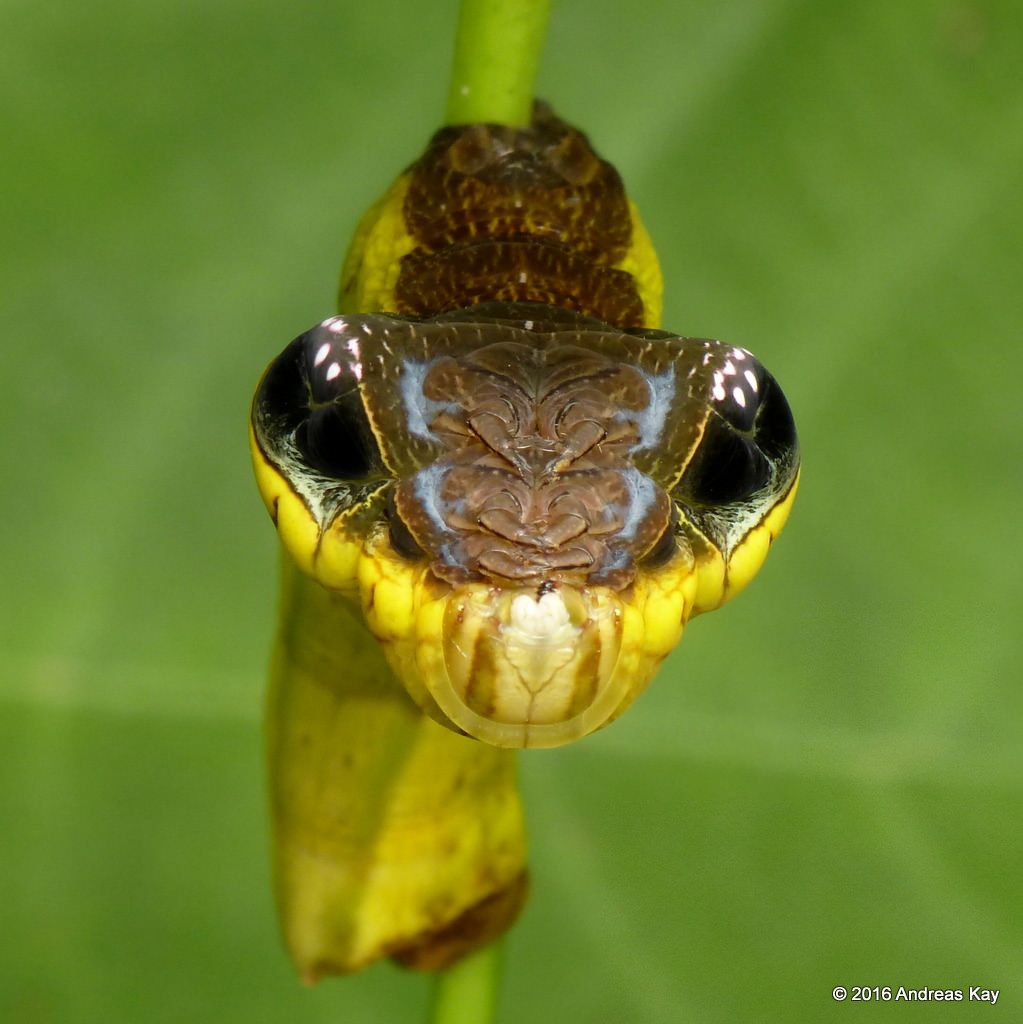
Credit: Andreas Kay / Flickr
11. Owl butterfly
Owl butterflies are species of the genus Caligo and are known for their huge eyespots, which resemble owls’ eyes. They are native to the rainforests and secondary forests of central and South America. These butterflies are very large, with a wingspan ranging between 6.5 – 20 cm (2.6–7.9 in), but they are not long-range fliers and fly only a few meters at a time. Due to this, they are easy targets for birds, so they usually fly at dusk, when there are fewer predators around.
Owl butterflies are very striking due to the yellow and black spots in the middle of their brown hind wings, which become visible when they are at rest. These ‘eyespots’ are believed to be a generalized form of mimicry. Patterns resembling eyes with a light-colored iris and a large pupil matches the appearance of the eyes of many predators that hunt by sight. The ‘dark owl eyes’ can ward off predators by confusing them as they see the face of a potential predator, thus allowing the butterfly to escape.

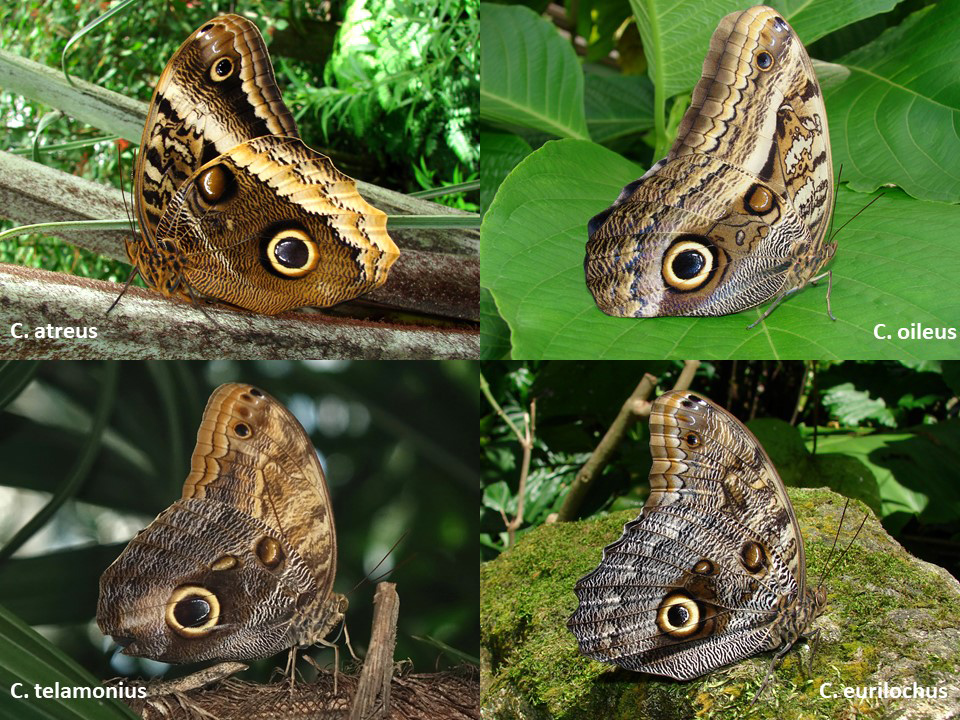
Credit: Ryan Fessenden (Florida Museum)
12. Spicebush swallowtail caterpillar (Papilio troilus)
The Spicebush swallowtail is a common black swallowtail butterfly found throughout North America. This insect has many predators including birds, spiders, robber flies, and dragonflies, which try to eat both adult butterflies and young larvae. In its early larva stage, the larva has a dark brown appearance to resemble bird droppings, which serves as camouflage from predators. At its fourth and last instar, the fully grown larva is up to 5.5 cm (2.17 in) long and takes on a yellow-green color with a pale yellow lateral line edged beneath with a fine black line. When it is ready to pupate, it turns an orange or yellow color as feeding stops.
On its thorax is a pair of large black dots with a white highlight or white “false reflection” creating the illusion of eyespots. These distinct features help the caterpillar to masquerade as common green snakes, thus fending off predators, especially birds. Taking the disguise a step further, it even mimics the behavior of snakes, as it rear ups and retract the actual caterpillar head in a menacing snake-like posture. When attacked, the larvae will reveal the osmeterium, a Y-shaped organ usually folded up within the caterpillar. The osmeterium is red in many Spicebush swallowtails, thus creating the illusion of a snake tongue and emphasizing the mimicry.
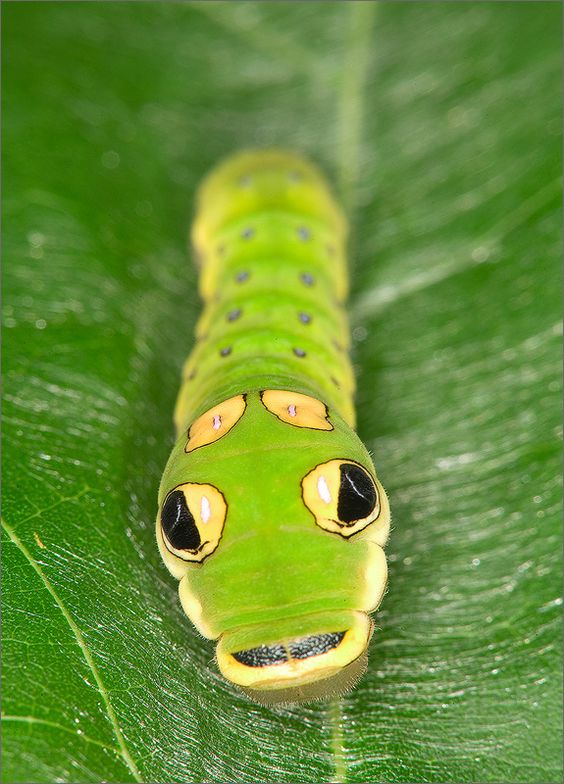
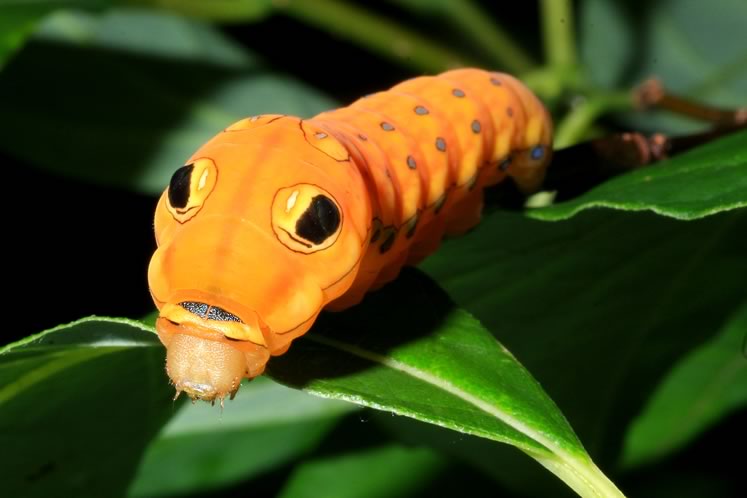
Credit: Don Scallen
Latest articles:
- Silent Killers of the Sea: Fishing Nets and the Devastating Impact on Our Oceans
- Amazing Ability of Sharks to Regrow Their Dorsal Fins
- Mountain Marvels: 7 Architectural Wonders Built into Nature’s Slopes
- The Frilled Shark: Jaws of the Abyss and a Living Fossil
- 30 Christmas Rock Painting Ideas – Last minute DIY crafts for Christmas decor, gifts and stocking fillers

